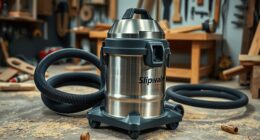To use an oscillating multi-tool effectively, start by selecting the right blade for your material, such as fine-tooth blades for wood or bi-metal for metal. Always wear safety gear, keep a firm grip, and work in well-ventilated areas. Inspect blades regularly and replace damaged ones promptly. Let the tool do the work, don’t force it, and control your cuts with steady, smooth movements. Keep going to discover even more tips for safe and efficient operation.
Key Takeaways
- Select the appropriate blade type for your material to ensure efficient cutting and safety.
- Always wear eye and hearing protection before operating the multi-tool.
- Secure workpieces firmly and work in well-ventilated areas to enhance control and safety.
- Regularly inspect blades for damage or dullness; replace as needed to avoid poor cuts or accidents.
- Use a firm grip and let the tool’s oscillation do the work, avoiding forcing or sudden movements.

An oscillating multi-tool is a versatile device that can make a variety of tasks easier and faster. Whether you’re cutting, sanding, grinding, or scraping, it’s a handy tool that adapts to your needs. However, to get the best results and guarantee your safety, understanding blade selection and safety precautions is vital. Choosing the right blade for your specific task is the first step. There are numerous blades available, each designed for different materials and functions. For cutting wood, you’ll want a blade with sharp, fine teeth, while metal cutting requires a bi-metal blade that can withstand tougher materials. When trimming drywall or making detailed cuts, choose blades with fine serrations for precision. Selecting the correct blade not only improves your efficiency but also minimizes the risk of accidents caused by slipping or blade failure. Always inspect your blades before use—look for signs of damage, such as cracks or dullness, and replace them if necessary. Using the wrong blade can lead to poor cuts, excessive vibration, or even dangerous kickbacks. Incorporating knowledge about skin exfoliation can help you understand how proper blade selection minimizes skin irritation when working on delicate surfaces.
Safety precautions should never be overlooked when operating an oscillating multi-tool. Always wear eye protection to shield your eyes from dust, debris, or small fragments that may fly off during cutting or sanding. Hearing protection is also recommended for prolonged use, as the tool can generate loud noise. Keep your hands clear of the blade’s path and ensure you have a firm grip on the tool to maintain control. When changing blades, disconnect the tool from the power source to prevent accidental activation. Follow the manufacturer’s instructions for mounting blades securely; loose blades can cause dangerous vibrations or dislodgement. Work in a well-ventilated area, especially when sanding or grinding, to avoid inhaling dust particles. It’s also wise to secure your workpiece firmly to prevent movement that could lead to slips. Never force the tool through a cut or material; let the blade do the work at its own pace. If you encounter resistance or unusual vibrations, stop immediately to check the blade’s condition and your grip.
Frequently Asked Questions
Can Oscillating Tools Cut Through Metal or Concrete Effectively?
Yes, oscillating tools can cut through metal and concrete effectively if you use the right blades. For metal cutting, choose bi-metal blades designed for durability, and for concrete demolition, use a segment saw blade or a diamond-coated blade. Keep in mind that cutting through thick or tough materials may take time and require multiple passes. Always wear safety gear and work carefully to guarantee clean, safe cuts.
What Safety Gear Is Recommended When Using an Oscillating Multi-Tool?
When using an oscillating multi-tool, you should always wear protective eyewear to shield your eyes from debris and dust. Hearing protection is also essential, especially during prolonged use, to prevent damage from noise. Additionally, consider wearing gloves to protect your hands and a dust mask if you’re working in a dusty environment. Staying safe guarantees you can work efficiently without risking injury or discomfort.
How Do I Change Accessories on an Oscillating Multi-Tool?
Changing accessories on your oscillating multi-tool is like swapping puzzle pieces. First, turn off the tool and unplug it for safety. Locate the accessory type—blade, sanding pad, or grout removal attachment—and loosen the accessory’s mounting mechanism, usually with a quick-release lever or a wrench. Then, remove the old accessory and align the new one properly. Tighten securely, ensuring it’s firmly attached before you start working again.
What Is the Ideal Power Source for Different Projects?
When choosing a power source for your oscillating multi-tool, consider your project needs. Corded models offer unlimited runtime and consistent power, ideal for heavy-duty tasks. Cordless tools provide portability and ease of use, especially with battery compatibility across multiple devices. For quick, light jobs, a cordless option is convenient. For prolonged, demanding work, a corded tool guarantees steady performance without worrying about battery life.
How Do I Troubleshoot if the Tool Isn’t Oscillating Properly?
Imagine you’re cutting through stubborn grout, but your multi-tool’s blade isn’t oscillating smoothly. First, check the blade alignment; misalignment can cause uneven operation. Listen for unusual motor noise, which might signal a motor issue. Confirm the blade is securely attached. If problems persist, inspect the brushes and connections. Properly aligned blades and a quiet motor usually mean your tool is working correctly again.
Conclusion
Mastering your oscillating multi-tool is like tuning a fine instrument—you need the right touch and technique. I once watched a DIYer carefully carve intricate details into hardwood, transforming a simple project into art. With patience and the right tips, you’ll release its full potential. Think of your multi-tool as a trusted ally; with each cut or scrape, you’re sharpening your skills. Soon, you’ll carve out perfection with confidence, turning every challenge into an opportunity for mastery.









